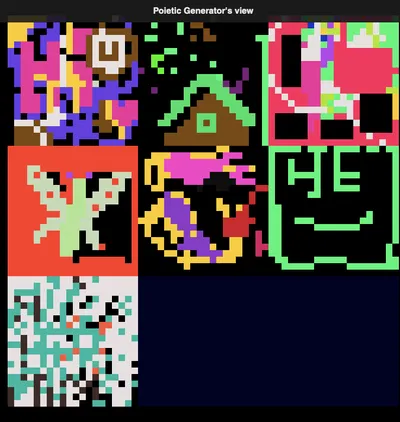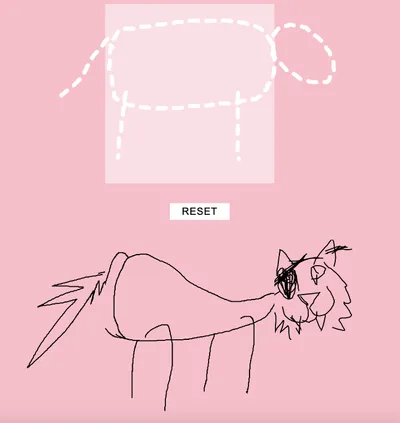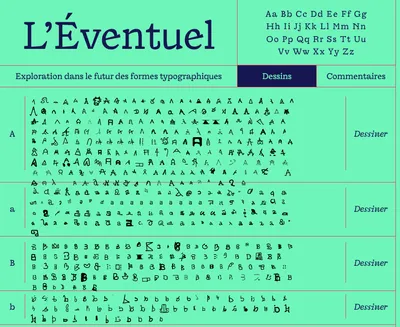Cooperative Games: Play Together, Esadse's workshop, 11-15 April 2021, Saint-Étienne (FR)
In connection with the objectives of the Digital Tools for Creative Collaboration project, the workshop aimed to provide an experiential understanding of the fundamental principles underlying collaborative work. Recognizing the challenges we faced during the initial workshop at EKA, where we struggled to reconcile our diverse design visions and methodologies, we believed that games, as a shared cultural artifact, would serve as a suitable foundation for our exploration.
Subject and goals of the workshop
Considering that games (including board games, video games, sports games, etc.) incorporate mechanisms that involve various forms of collaboration, we decided to center the workshop around the concept of collective play. While many games emphasize competition, only a few are centered on collaboration and cooperation, allowing participants to work together towards a shared victory instead of playing against each other.
During the workshop, we introduced two guiding principles:
- Designing games collaboratively in small groups.
- Developing rules that encourage collaboration as a means to achieve success.
Esadse provided resources such as laser cutting, 3D printing, and VR headsets to support the creation of prototypes that could be played on the final day.
Workshop's schedule

Talk: Notions about cooperative games
As an introduction to the workshop, David-Olivier Lartigaud discussed cooperative games, drawing upon references such as the book "Rules of Play: Game Design Fundamentals" by Katie Salen Tekinbaş and Eric Zimmerman (MIT Press, 2003), as well as other sources mentioned in the text.
Conditions for a game to exist
- Every game exists within a defined framework, encompassing a specific time and space, which communicates to players that they are engaged in a game.
- The magic circle, a concept introduced by Johan Huizinga in his book "Homo Ludens" (1938), defines the space in which a game unfolds. Unlike informal play, which lacks clear boundaries, games establish a formalized structure that explicitly delineates the magic circle.
- Within the magic circle, the game's rules create a special set of meanings for the players of a game. These meanings guide the play of the game.
- As a system, a game can be considered to have an open or closed relationship to its context. Considered as RULES, a game is closed. Considered as PLAY, a game is both open and closed. Considered as CULTURE, a game is open.
- The lusory attitude refers to the state of mind necessary to engage in gameplay. It entails a collective acceptance of the rules' constraints, driven by the enjoyment and satisfaction that games offer.
- Rules form the fundamental structure of games, defining the parameters and interactions within which players operate.
- Rules limit player action
- Rules are explicit and unambiguous
- Rules are shared by all players
- Rules are fixed
- Rules are binding
- Rules are repeatable
While there are games that challenge and deviate from these characteristics, these traits represent the general attributes of game rules when viewed strictly from a formal perspective.
Games as systems of conflict
- How many players can participate in the game?
- Is the gameplay simultaneous or turn-based?
- Does the game include a high score list?
- Do players receive continuous feedback on their relative scores?
- Does the game provide opportunities for players to compare their scores and game statistics?
- Are there computer-generated opponents and obstacles that players collectively face, or do the players compete against each other?
- Does the game structure allow for direct conflicts between players?
- Are there resources in the game that players can compete for?
- Can players use money to continue playing or enhance their gameplay?
Coopetition or co-opetition (sometimes spelled "coopertition" or "co-opertition") is a neologism coined to describe cooperative competition. Coopetition is a portmanteau of cooperation and competition. Basic principles of co-opetitive structures have been described in game theory (source: "Coopetition," in Wikipedia).
Talk: How to make a collaborative game?
Mathias Hû, an Esadse student, presented his incomplete brand game project: Run-off. The purpose of the presentation was to highlight the issues and difficulties involved in creating a collaborative game. Here are some key points discussed:
- When designing a game for multiple players, it becomes crucial to consider how they interact with each other.
- The most common approach is through competitive gameplay, where all players compete against each other to win. This can be seen in games like Street Fighter, Risk (territorial conquest), or Mario Kart (racing for first place).
- Alternatively, players can be grouped into different teams, introducing cooperative relationships within each team. While competition still drives the game, it fosters collaboration. Examples include team sports like basketball, multiplayer games like Overwatch, or brand games like Time's Up.
Finally, if you want to create a game that focuses solely on cooperation without any competitive aspect between players, you need to provide a new motivation for players to engage in the game. Competition is often used because it easily attracts people to play and keeps them engaged. However, there are alternatives to drive cooperative gameplay. Here is an initial list of alternatives for the core concept of cooperative games:
- The desire to create something together can be a sufficient motivation. This is evident in certain Minecraft servers or construction games like Lego or Kapla (although the latter two may be more accurately classified as toys with the potential for creating games).
- In other cases, exploration serves as a driving force for player engagement. This is observed in narrative, linear, or puzzle games. The collective desire to uncover the next step, part of the story, or environment motivates players to continue together. Examples include games like Broforce or Portal 2 in cooperative mode, as well as many role-playing games.
- The game itself can serve as the opponent for a collective team of players. In this case, the game presents challenges that the team must overcome or achieve the most desirable score.
All of these motors can be combined and many games use a combination of them.
Run-off

Run-off is an incomplete brand game project that initially aimed to create a competitive game but with a twist: adopting a non-cooperative strategy proves to be counterproductive for all players involved. The game begins with individual players pitted against each other, but as the game progresses, teams gradually form, and collective strategies are built. In the game, each player is responsible for managing a floor of tubes in a tower. Rain falls on the top floor and runs off through each subsequent floor until it reaches the ground. On the ground, each player has a vase and must collect as much water as possible. However, without collective coordination, the water is wasted for everyone.
Difficulties and conclusions
The game became too complex and required a high level of spatial projection, which made it challenging to play. Additionally, certain rules within the game system were unbalanced, further hindering its playability. These various aspects ultimately rendered the game unplayable.
This experience has significantly influenced my approach to game creation. I believe it is crucial to start with a concept that is not overly complex and focus on achieving a balanced and playable situation initially, before adding additional features. Maintaining this balance is delicate, so it is important to extensively test the game with each rule change to ensure its preservation.
The use of metaphors or narratives can be highly beneficial when introducing new rules or features, as they tap into our familiarity with the concepts they represent. This familiarity makes it easier for players to understand and apply these elements. In the case of Run-off, the concept of gravity was utilized, allowing players to grasp the intricate movement of water without the need for extensive explanation, given their existing familiarity with the concept.
Talk: Collective creation(s) based on a contributive model
Samantha Zannoni, a Third Cycle student at Esadse, presented her collective experiment using Olivier Auber's poïétique generator. This net artwork was originally designed and programmed in 1987 as a form of free art.
Currently, the artwork has been further developed using Ruby on Rails and JavaScript, allowing anyone to connect to the webpage. Users have access to a set number of pixels and can draw simultaneously within their designated strip. The objective of the artwork is not to determine winners or losers but rather to collaboratively create something

Samantha also introduced various references of collective creations based on a contributive model.
Otherti.me, Raphäel Bastide, 2019
An experiment conducted by the French designer Raphäel Bastide, during the lockdown.

L'éventuel, Bonjour Monde, 2019
A contributive typography made by Bonjour Monde, which invites people to contribute to the creation of a new typography.

Shared references: Video games
In some MMORPGs, such as those with Guild systems, players must join forces and work together to conquer dungeons or defeat powerful enemies, drawing inspiration from tabletop RPGs. Participants engage in discussions, solve puzzles, and coordinate strategies to overcome challenges.
Additionally, many sandbox games offer cooperative or collaborative modes. For example, in GTA, players can team up to carry out bank heists, while Minecraft allows players to collaborate on building projects. However, the gameplay of these games is not exclusively focused on cooperation, as players can also pursue individual activities.
On the other hand, there are games specifically designed to require cooperation in order to complete or win.
Below are a few examples along with brief comments showcasing the significance of collaboration in these games:
It Takes Two / A way out
Two players must cooperate to complete tasks. It is the complementarity and coordination of actions that counts.
Overcooked
Working together to go fast. What is interesting is that everyone redistributes tasks according to the situation in order to be as efficient as possible.
Nvidia omniverse
Not a game but proceeds on the same principle. Everyone collaborates on a specific task to obtain a quick result.
Among Us
In this game, there're tasks to be done with a common goal (just a pretext), but the real goal is to find an imposter. Here's an interesting disruptive element, like a bad collaborator. No synchronization or coordination between actions necessarily. Everyone does their own thing until it is time to discuss for eliminating a player. It's a bit like some TV shows where several people in a loft vote to eliminate a roommate. (In the case of Among US, which is map-based, it is easy to imagine an adaptation in the form of a board or a card game.)
Out of Space
It's a collocation game. You have to maintain a space station, avoid dirt, have food, etc.
Keep Talking And Nobody Explodes
Collaboration when the players are not at the same level of information.
Alternate Reality Games (ARG)
ARG has the power to create communities searching together to solve a riddle. The cooperation is active after the start of the game and not before, as in many games. In this case, we can speak more about contribution, which is a very specific type of cooperation.
Heave-Ho
This game is just a lot of fun! It also involves the exploration of a collective movement created by the addition of individual movements.
A Way Out
A videogame created to be played in coop mode only.
Brothers : A Tale of Two Sons
This game offers you the possibility to control two characters with a single controller. Although it is intended to be played by only one person, it can easily be played by two. This creates a new relationship with the controller as an individual object and introduces a new way to play collectively.
Medieval games
This game for four players is released on Wii. It simulates a brand game where each player competes against the others. In each round, all players participate in a mini-game, and the winner(s) receive rewards within the overall brand game. The mini-games create various collective structures, including 1v1v1v1, 2v2, 1v3, and 1v1 with two players who can assist or hinder one another. These dynamics create alliances and implicit teams among the players.
Shared references : Board games
Mafia/The Werewolves of Millers Hollow
Two sides engage in a collaborative competition where they silently exchange information to strategize against each other.
5-Minute Dungeon
A very simple cooperative game!
Legend of Andor
A very complicated cooperative game!
The Mind
It's a very simple board game where players must collaborate on a task without the ability to communicate verbally. It presents an interesting challenge of how to achieve a goal with a significant constraint.
Mansion of madness - 2nd edition
The game master is a tablet that provides instructions for solving puzzles together and battling enemies."
Cerberus
In this brand game, all players start as survivors who must escape from the cerberus. Cooperation is essential for this objective. However, as everyone has the potential to be saved, players must sacrifice one another as each individual who joins the cerberus's team becomes an obstacle in their path.
Puzzles
It will be interesting to understand how puzzles, with their ultra-simple principles, can create collective relations and lead to the formation of monuments
Concept
This game is a 'describe and guess' game where players have to describe a concept using a combination of pictograms representing simple concepts. The interesting aspect of this game is that while it was originally created with competitive features, they can feel unnatural and players often choose to abandon them and play in cooperative mode for the sake of fun.